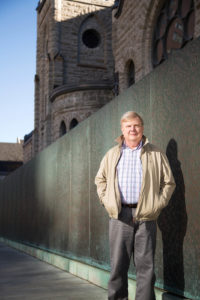 Per Lindstrand sees obstacles as stepping stones as he develops new methods and products for fabric engineering.
Per Lindstrand sees obstacles as stepping stones as he develops new methods and products for fabric engineering.
Never be afraid to stick your head out. I’d rather have my head slapped one time too many than too little,” says aeronautical engineer Per Lindstrand, founder and president of Lindstrand Technologies, Oswestry, U.K. “You get nowhere unless you take chances—and if you fail, try again.”
An engineering officer in the Swedish Air Force in the 1970s, Lindstrand was grounded due to a medical condition, and the only thing he could fly without breaking regulations was a hot air balloon. So he made a homemade balloon and flew it across the runway. “That alone didn’t make me determined to become a balloon manufacturer,” he says. “It was several years later when my neighbor bought a balloon for quite a lot of money and I laughed at it. I told him I could make one in an hour and I did, which led to him suggesting we become balloon manufacturers. Without a thought about being a balloon manufacturer, suddenly I was one.”
Lindstrand’s neighbor provided the financial backing while Lindstrand provided the engineering, and the two launched Colting Balloons in Ireland (named after his partner Håkan Colting). In 1978 Lindstrand bought his partner out, renamed the company Colt Balloons and moved it to Oswestry, U.K., due to the U.K.’s weak pound. A few years later, Colt merged with Thunder Balloons, which later merged with Airborne Industries.
Going the distance
Although Lindstrand holds several ballooning records, it was his 1987 crossing of the Atlantic with Sir Richard Branson (founder of then Virgin Atlantic Airways, now Virgin Group and Virgin Galactic) that he credits for bringing ballooning into the public consciousness. Lindstrand designed and piloted the balloon they used to pioneer flying in the jet stream, a trip that quadrupled the distance any balloon had ever flown. “That had a lot of effect on the ballooning world. The Balloon and Airship Club doubled overnight, and everybody started talking about balloons,” Lindstrand says. “It brought us up into the technological elite in designing balloons and air ships.”
Despite Lindstrand’s ingenuity and accomplishments he soon found himself on the receiving side of a boardroom coup—and consequently without a job. “In ’91 I was booted out of the company,” he says. “We had multiple city slicker-type shareholders who thought they knew better than I did so they kicked me out—and so I started Lindstrand Balloons. Three years later [Airborne Industries] was bankrupt and I bought up its remains from the receiver.”
 Shape shifting
Shape shifting
Lindstrand Balloons, now Lindstrand Technologies, makes inflatables, including aerostats, hot air balloons, air ships and tunnel plugs. However, the hot air balloon market, according to Lindstrand, is declining badly, which means his focus has turned elsewhere. “Tethered aerostat systems are expanding widely,” he says. “Tethered systems can fly any time of day. They can fly in coastal areas. For free-flying balloons the limitations are quite severe, so the future [for this market segment] is definitely tethered aerostats.”
Currently Lindstrand and his team are working on a tethered aerostat to replace the HiFlyer, a balloon Lindstrand Technologies introduced in 1996 that accommodates up to 30 passengers. “The HiFlyer is a round balloon with a drag problem—you can only fly it up to 25 knots,” Lindstrand says. “The SkyFlyer, which is the aerostat-shaped version, can fly up to 40 knots and can fly 365 days a year.”
Lindstrand expects the first SkyFlyer to be launched in Miami, Fla., in the next few months. “We wanted something with more performance than what is available with a round balloon and I thought of using an aerostat instead,” he says. “The idea came from me but the solution was a team solution.”
Well grounded
Inflatable applications are not limited to flight. Lindstrand has diversified his business during the past few years to include inflatable building designs as well. “We realized as we were building special shapes of hot air balloons that we could use our programs to develop advanced inflatables for buildings,” he says. “We now have a range of high-quality buildings primarily for the military .”
Lindstrand Technologies designs and manufactures inflatable hangars for helicopters and other aircraft for the U.S. Marine Corps, for example, which has about 200 of the company’s hangars. “The buildings are too expensive for private use so it’s primarily the military that can afford them,” he says.
Metal-framed buildings covered with fabric are the main competition for the inflatable buildings, but Lindstrand points out that there are drawbacks to the competition’s structures. “If those buildings are exposed to hurricane-force winds, the metal will bend and the building will be useless,” he says. “With our buildings, because they’re all fabric, if a strong wind comes they act like a wind sock. They can stand up again and there’s no damage.”
 Air control
Air control
No matter what the project, it’s the challenge of the process that attracts Lindstrand and his team, and often that challenge is presented by an obstacle or even disaster. One such tragedy that spurred Lindstrand to create an innovative solution was the Mont Blanc tunnel fire that claimed 38 lives in 1999 in the tunnel under the Mont Blanc Mountain in the Alps. “We realized that firefighting in modern tunnels was still antiquated,” Lindstrand says. “People didn’t stand a chance because the fire fighters couldn’t go in until the fire burned out.”
Lindstrand and his staff devised an inflatable plug, which seals the tunnel, cutting off air flow to the fire. The plugs are manufactured from a medium-weight glass fiber fabric, coated with silicone.
The tunnel plugs are not used only in tunnels but also in nuclear power stations. Lindstrand Technologies installed the system in one power station, the location of which it can’t disclose. “We can isolate the whole power station in 1-½ seconds to keep it from leaking,” he says. “Had the Japanese power station had our system when the tsunami hit in 2011, they would have been able to stop the leak.”
Although the possibilities for inflatables may seem limitless to Lindstrand, he finds that they can be a hard sell at times. “It can be tough to get potential clients to consider a solution that you know is good but they are unfamiliar with,” he says. “One of the best things that has helped me is air bags in cars. I ask the clients if they trust their air bags—and if they trust their air bags, why wouldn’t they trust my inflatables?”
Sigrid Tornquist is a writer and editor based in St. Paul, Minn.
Five tips for innovation
- Never say never. Be willing to take risks.
- Let the problem guide you to a solution.
- Provide ideas to a well-trained team and let the solution be a team solution.
- Approach failures as learning opportunities. They are steps on the way to your goals.
- Embrace new materials and methods.
 The world’s biggest aerostat
The world’s biggest aerostat
When the planners of the Delhi 2010 Commonwealth Games needed a company that would not shy away from the challenge to design and manufacture the biggest aerostat ever built to act as a “floating” projection screen, they enlisted Lindstrand Technologies. The helium-filled aerostat that ultimately hovered above the games held in Jawaharlal Nehru stadium in Delhi, India, was conceived by Mark Fisher, who has designed events such as the Beijing Olympics opening ceremony—but it was brought to reality by Per Lindstrand and his staff.
The aerostat was 80 meters long, 40 meters wide and 12 meters high. Built in four sections, connected using zips and Dutch lacing, the structure used five kilometers of fabric. Its shape was based on the torus—a donut-shaped product of two circles. Graphic solutions company MediaCo, Manchester, U.K., digitally printed a “skirt” for the aerostat that depicted Indian symbolism as a finishing touch. “When the Commonwealth Games [committee] contacted us six months before the event, the stadium was already built and they had 22 projectors—but they had nowhere to project [the images for the opening ceremony],” Lindstrand says. “They came to us and we took it on—it was quite an exciting project.”
Are there any failures you’ve had that are particularly memorable?
Our first attempt to cross the Pacific in 1989 failed. The balloon froze to the ground and everything came off it. It was a spectacular failure because it was in front of the world’s live TV cameras. That taught us to be more cautious in certain ways, and we went back the year after. It’s natural for humans to take chances, and I just think you hang in there and go for it.
Are there any developments in materials that are changing the way you design?
Yes. For example, we are using more and more Vectran® [liquid crystal polymer fiber]. Vectran is to polyester what Kevlar® is to nylon. It’s a high-strength fiber with better fatigue properties than Kevlar. It decreases the weight of the structure, making it far easier to inflate. We’ve been using it for five or six years.
 TEXTILES.ORG
TEXTILES.ORG


